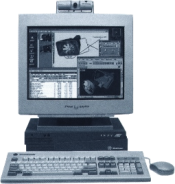 . home
. interests
. indy
.
. home
. interests
. indy
.
Silicon Graphics introduced the Indy in 1993 as an entry into the personal desktop market. It was released with a 384MB hard drive, 16MB RAM, and the MIPS R4000 100MHz CPU. By today's standards those are pitiful numbers, but given the memory and storage costs of the day, combined with the RISC architecture of the CPU, it was an impressive machine. But what really made the Indy a breakthrough was the well-known SGI 3D graphics hardware.
 The Personal Iris, Indigo, and Indigo2 series of machines in the
late 80's and early 90's became popular because of their hardware-
accelerated 3D graphics systems. Bringing that to the desktop in
the Indy, combined with the new Irix 5.3 and IndigoMagic desktop,
made the Indy a very popular machine in the mid-90's. It also
came standard with ethernet, ISDN, built-in video, audio, and
SCSI-2 connections.
The Personal Iris, Indigo, and Indigo2 series of machines in the
late 80's and early 90's became popular because of their hardware-
accelerated 3D graphics systems. Bringing that to the desktop in
the Indy, combined with the new Irix 5.3 and IndigoMagic desktop,
made the Indy a very popular machine in the mid-90's. It also
came standard with ethernet, ISDN, built-in video, audio, and
SCSI-2 connections.
 I got my Indy in college in early 1995 to replace my 386
Slackware Linux
PC. Mine came with 64MB RAM, a 1 gig HD (that was huge!),
and I later got the R5000 processor upgrade to 150MHz. It
also came with a video camera called the IndyCam (w00t!).
This machine enabled me to do all my Computer Graphics class
work in the comfort of my dorm room.
I got my Indy in college in early 1995 to replace my 386
Slackware Linux
PC. Mine came with 64MB RAM, a 1 gig HD (that was huge!),
and I later got the R5000 processor upgrade to 150MHz. It
also came with a video camera called the IndyCam (w00t!).
This machine enabled me to do all my Computer Graphics class
work in the comfort of my dorm room.